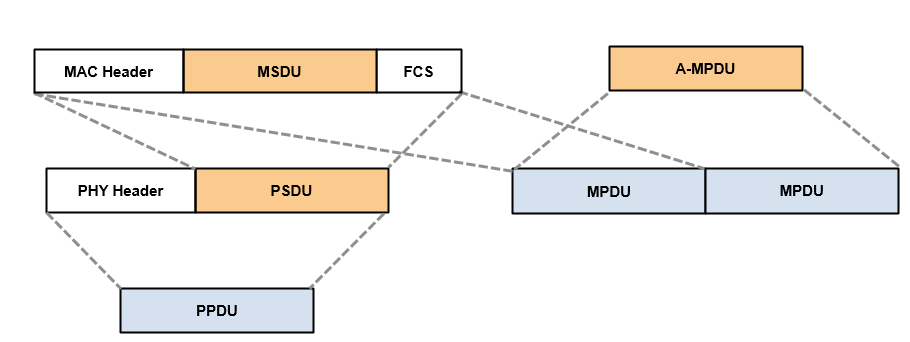WLAN MAC Frame Structure
802.11 MAC Protocol
The IEEE® 802.11™ family of standards implements the medium access control (MAC) layer as a frame exchange protocol. By means of this protocol, the sender of a MAC frame can determine when the intended recipient successfully receives that frame. The sender transmits the MAC frame in the data field of a physical layer convergence procedure (PLCP) protocol data unit (PPDU). For more information on WLAN PPDU content, see WLAN PPDU Structure. For more information on the role of the MAC layer in WLAN message exchange, see What Is WLAN?
General MAC Frame Format
Section 9.2.1 of [1] specifies that the general MAC frame must consist of a MAC header, frame body, and a frame check sequence (FCS). MAC frames can be either protocol version 0 (PV0) or protocol version 1 (PV1). WLAN Toolbox™ supports only PV0 MAC frames. For information on PV1 MAC frames, see Section 9.8 of [1].
This figure shows the fields comprising the MAC header of a PV0 MAC frame and their sizes in octets.

As indicated in Section 9.2.4 of [1], all MAC frames contain the first three header fields and the FCS. The frame type and subtype determine the additional fields that are contained in the frame.
The frame body, which immediately follows the header, has a variable size. Table 9-25 in [1] specifies the maximum size and duration of the frame body for non-HT, HT, VHT, and HE PPDU formats.
The FCS consists of a four-octet cyclic redundancy check (CRC), which the sender computes based on the frame header and body in accordance with Section 9.2.4.8 of [1].
The combination of MAC header, frame body, and FCS defines a MAC protocol data unit (MPDU). This figure shows the structure of an MPDU and its placement within a PPDU.

To increase throughput, IEEE 802.11 supports the formation of aggregate MPDUs (A-MPDUs) by concatenating multiple MPDUs. For more information on MPDU aggregation and A-MPDU structure, see section 9.7 of [2].
MAC Frame Types
IEEE 802.11 supports four types of MAC frame: Management, Control, Data, and Extension frames. Within each of these types, the standards define a variety of subtypes. Table 9-1 of [1] provides a list of the valid types and subtypes, and section 9.3 provides detailed information on frame formats by type and subtype.
This table shows the some of the supported frame types and subtypes for HE, VHT, HT, and non-HT transmission formats. For information on the format of any of these MAC frames, see the relevant sections of [1] and [2].
| Frame Type | Frame Subtype | Described in This Section of the Standards |
|---|---|---|
| Control | Request to Send (RTS) | 9.3.1.2 of [1] |
| Control | Clear to Send (CTS) | 9.3.1.3 of [1] |
| Control | Acknowledgement (Ack) | 9.3.1.4 of [1] |
| Control | Block Ack | 9.3.1.8 of [1] |
| Control | Trigger (Basic) | 9.3.1.22 of [2] |
| Control | Trigger (MU-BAR) | 9.3.1.22 of [2] |
| Control | Trigger (MU-RTS) | 9.3.1.22 of [2] |
| Data | Data | 9.3.2.1 of [1] |
| Data | Null | 9.3.2.1 of [1] |
| Data | Quality of Service (QoS) Data | 9.3.2.1 of [1] |
| Data | QoS Null | 9.3.2.1 of [1] |
| Management | Beacon | 9.3.3.2 of [1] |
Each frame type serves a distinct purpose in an 802.11 network.
Control frames support the delivery of data, management, and extension frames. For example, acknowledgement frames confirm that the intended recipient of a frame has successfully received it. Control frames do not contain a frame body, consisting only of a frame header and FCS.
Data frames contain data from higher layers in a MAC service data unit (MSDU). To support higher throughput, data frames support aggregate MSDUs (A-MSDUs), which comprise multiple concatenated MSDUs in addition to the MAC header and FCS. For more information on MSDU aggregation, see section 9.3.2.2 of [1].
Management frames establish and maintain connections by carrying information related to the capabilities and configurations of devices operating within a network.
Extension frames extend each of these frame types for use in an 802.11ad™ directional multigigabit (DMG) transmission.
The Generate and Parse WLAN MAC Frames tutorial demonstrates the basic steps of MAC frame generation and decoding with WLAN Toolbox functions and configuration objects.
The 802.11 MAC Frame Generation example shows how to generate control, data, and management frames, and how to export frames to a packet capture (PCAP) file for analysis.
References
[1] IEEE Std 802.11-2020 (Revision of IEEE Std 802.11-2016). “Part 11: Wireless LAN Medium Access Control (MAC) and Physical Layer (PHY) Specifications.” IEEE Standard for Information Technology — Telecommunications and Information Exchange between Systems — Local and Metropolitan Area Networks — Specific Requirements.
[2] IEEE Std 802.11ax™-2021 (Amendment to IEEE Std 802.11-2020). “Part 11: Wireless LAN Medium Access Control (MAC) and Physical Layer (PHY) Specifications. Amendment 1: Enhancements for High Efficiency WLAN.” IEEE Standard for Information Technology — Telecommunications and Information Exchange between Systems. Local and Metropolitan Area Networks — Specific Requirements.
[3] Gast, Matthew. 802.11ac: A Survival Guide. 1st ed, O'Reilly, 2013.